Pipeline Woes & Fears : A Well Thought Out Scream by James Riordan
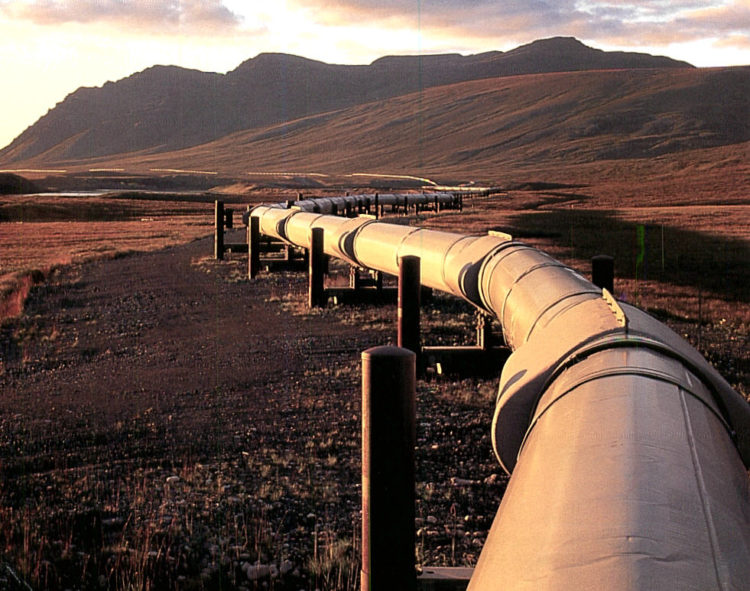
Recent pipeline accidents and other problems have revealed that Americans depend on a single pipeline to deliver the gasoline that fuels their everyday lives. And that pipeline is operated by a single, little-known company with an increasingly troubled safety record. Built in 1962, the Colonial was the largest private-sector infrastructure project of its time. Roughly half of all refined fuel products used in cities from Georgia to New Jersey run through its 5,500 miles, which branch out from oil refineries in Texas and on the Gulf Coast to gas stations in America’s most populated corridor. In 1999, Colonial Pipeline paid a fine of $7 million—the biggest ever at the time—for a massive spill in South Carolina. Four years later, it was fined $34 million, a new record, for spilling 1.45 million gallons of oil in five states.
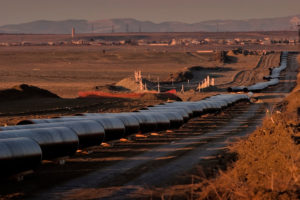
Construction on the BTC pipeline and associated gas pipeline. Piping along the BTC right of way near Rustavi.
At the same time, Colonial has benefited from an increasingly dense regulatory environment for pipeline construction, which has helped protect it from competition and make it something of a piggy bank for its owners, to whom the company returns annual dividends that typically total about $300 million. Colonial’s pipeline consistently runs at 100 percent capacity, leaving gasoline refiners and fuel merchants, who pay transport rates in a manner akin to a toll road, vying for space. The company, headquartered in Alpharetta, a suburb of Atlanta, is privately held by a consortium of investors. The largest is Koch Industries, with a 28 percent stake; others include the private equity firm KKR, Shell Pipeline, and South Korea’s National Pension Service.
Tight capacity and the millions of gallons of new oil supplies produced by the U.S. shale boom have made some operators and industrial customers eager to build additional pipelines. Companies that rely on the Colonial, including American Airlines, are among those pressing for expansion. But although pipeline operators maintain that moving fuel underground is cheaper and safer than moving it by rail, barge, or truck, resistance to more construction has grown fierce, and not just in liberal communities. In addition to ongoing protests by Native American and environmental activists over the Dakota Access Pipeline in North Dakota, some deeply conservative Southern counties have opposed projects as well.
On Halloween afternoon, nine men arrived at a wooded ridgeline in rural Alabama. They parked their vehicles next to a gravel road, forming a loose circle of pickup trucks, a semi, and an earth-moving track hoe. A driver turned on the track hoe and drove it down into a long stretch of grass that ran along a hillside—the right of way for the Colonial Pipeline, the largest gasoline pipeline in the U.S. Beneath the ground, a 3-foot-wide steel tube carried roughly 1.4 million barrels of gasoline each day to 50 million Americans in cities up and down the Eastern Seaboard.
The men were there to conduct repairs. Just over a month before, the pipeline had sprung a leak, forcing a shutdown that caused gasoline reserves on the East Coast to fall from 64 million barrels to 55.5 million, the biggest one-week drop in U.S. history. Prices spiked at the pump in many cities from Atlanta to Jersey City. The leak had been fixed temporarily with a bypass, and now the crew was excavating about 5 miles from the original rupture to rebuild the stretch that had failed. They worked for a local contractor, L.E. Bell Construction, that the pipeline’s owner, Colonial Pipeline Co., had hired many times over the years
Among the team was Anthony Lee Willingham, a 48-year-old track hoe operator who’d been with L.E. Bell for almost 30 years. He was familiar enough with the routine procedures of pipeline repair to have built a kind of muscle memory. If he was at the wheel—the company hasn’t confirmed this—he would have known to operate the track hoe blade slowly, deliberately, without applying too much pressure. But somehow the blade struck steel, and the fuel ignited.
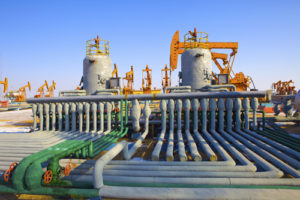 At that moment, not far down the gravel road, a farmer named Douglas Wright was at home playing with his granddaughter. The explosion shook the house to its foundations. Wright looked outside and saw a column of flame rising hundreds of feet in the air. Black smoke billowed into the blue sky. He told his wife to take their granddaughter and drive as fast as possible, then he headed toward the fire, thinking to check on some elderly neighbors. As he got closer to the site, he heard screams. Wright arrived to find some of the workers on the ground, severely burned, as their uninjured colleagues tried frantically to move them away from the flames. The track hoe was charred. The semi was obliterated, and the pickup trucks were on fire. Amid the wreckage was the body of Willingham. Authorities were unable to collect his remains until the next day.
At that moment, not far down the gravel road, a farmer named Douglas Wright was at home playing with his granddaughter. The explosion shook the house to its foundations. Wright looked outside and saw a column of flame rising hundreds of feet in the air. Black smoke billowed into the blue sky. He told his wife to take their granddaughter and drive as fast as possible, then he headed toward the fire, thinking to check on some elderly neighbors. As he got closer to the site, he heard screams. Wright arrived to find some of the workers on the ground, severely burned, as their uninjured colleagues tried frantically to move them away from the flames. The track hoe was charred. The semi was obliterated, and the pickup trucks were on fire. Amid the wreckage was the body of Willingham. Authorities were unable to collect his remains until the next day.
Aftershocks quickly shuddered up the spine of America’s energy system. When gasoline traders realized that East Coast reserves were once again threatened, they started bidding up the price of fuel. In a matter of hours, the cost of a gasoline futures contract for December shot up 15 percent, the highest jump since the financial crisis in late 2008. Merchants scrambled to secure supplies from tankers carrying imported fuel, causing the cost of cargo freight from the Atlantic to surge more than a third, to about $17 per metric ton, according to data compiled by Bloomberg.
Minutes after the explosion in Alabama, David Butler’s cell phone started ringing. Butler is a local leader of Riverkeepers, an alliance of activists who protect watersheds and rivers around the country. As Riverkeeper for the Cahaba, which snakes between the sites of the Colonial gas leak in September and the explosion in October, he counts among his responsibilities testing for pollution and responding to reports of sewer leaks. Colonial had also enlisted him to help monitor for pollution from its line and with cleanup after spills. That afternoon, Butler and his wife, who live about 20 miles from the blast, were preparing to take their kids trick-or-treating. His daughter was going to be Little Red Riding Hood, his son the Big Bad Wolf.
The first calls were from neighbors, asking if he knew what had happened. Then Colonial got in touch and confirmed that the fire had begun with an explosion. The implications were dire: Hundreds of thousands of gallons of fuel could be pouring into nearby creeks and rivers, imperiling the Cahaba’s 173 species of fish and mussels, 14 of which are listed as threatened or endangered. The waterway is also home to the rare Cahaba river lily, which attracts thousands of tourists after it blooms each May. (Local drinking water supplies were safe, since they’re drawn from a river farther away.)
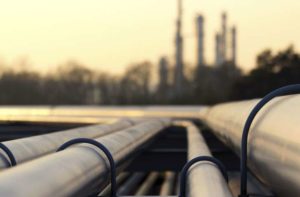 That evening, Butler arrived at the improvised command center Colonial had set up at a community building in the town of Pelham. After being cleared by security, he entered a large, gymnasium-like room where a disaster response team was working on a plan to contain the fire and assess the damage. Butler might have seemed out of place amid the fire department staff, pipeline personnel, and officials from the Environmental Protection Agency and other government bodies. With his dark beard, wiry frame, and casual clothing—he often wears jeans and a yellow Riverkeeper T-shirt—he typically looks like he’s just finished a long hike. He also has the metabolism of a hummingbird, frequently fueling himself with Powerade and miniature chocolate-chip cookies.
That evening, Butler arrived at the improvised command center Colonial had set up at a community building in the town of Pelham. After being cleared by security, he entered a large, gymnasium-like room where a disaster response team was working on a plan to contain the fire and assess the damage. Butler might have seemed out of place amid the fire department staff, pipeline personnel, and officials from the Environmental Protection Agency and other government bodies. With his dark beard, wiry frame, and casual clothing—he often wears jeans and a yellow Riverkeeper T-shirt—he typically looks like he’s just finished a long hike. He also has the metabolism of a hummingbird, frequently fueling himself with Powerade and miniature chocolate-chip cookies.
That first night, Butler worked with Colonial employees and environmental contractors until roughly 3 a.m. to draw a map that showed where gasoline might be leaking into the Cahaba. One point of concern was a creek near the explosion that fed into the river. This small stretch of water is the isolated habitat of the oblong rocksnail, a species thought to be extinct until a small population was found in 2011. Butler and Colonial decided that in the morning they would test strategic points along the waterways for the presence of fuel.
As they worked that night, the fire was spreading along the hillside to nearby forested land. Alabama was in the middle of an historic drought, which had left the forest floor covered with dry tinder. About 31 acres of land were engulfed overnight. Butler considered it a stroke of luck that the fire wasn’t encroaching on the suburban communities dotting the highways between the explosion and Helena, a town 21 miles south of Birmingham. Colonial had moved swiftly to shut off the flow of gasoline in the pipe, leaving it to burn itself out as firefighting crews doused the edges of the blaze and built earthen berms to contain the fountain of ignited fuel. When Butler arrived in the morning to start collecting water samples, the fire was largely contained, but it remained about 20 feet high.
As he went from site to site, the early indications looked promising: no oily sheen on the water, no odor of gas. He did, however, notice a somber air among the pipeline employees and contractors. They seemed almost embarrassed, he thought. Colonial had been having a very bad year in Alabama. The company had already reported five leaks from its pipeline in 2016, one less in 10 months than it had had in the previous five years. In late January, the Colonial had discharged about 126 gallons of fuel into nearby wilderness. Several smaller spills followed, culminating in the big leak in September, when 309,540 gallons of gasoline poured out of the line, filling local ponds and forcing the shutdown.
Records from the federal Pipeline and Hazardous Materials Safety Administration (PHMSA) show that nationally, the number of reported pipeline accidents has been creeping up every year since 2012, from 573 that year to 715 in 2015. The number of reported accidents along the Colonial has also been climbing (though not in a straight line), from 12 in 2011 to 27 in 2015. Their cost, too, has been increasing. Last year, incidents involving the Colonial led to $18.1 million in property damage and cleanup outlays, the highest total by far over the preceding decade. This year, the figure had already reached $75.6 million before the accident on Oct. 31.
Colonial refused to comment on what caused the September leak or why accidents are up sharply in Alabama this year. Malesia Dunn, a spokeswoman for Colonial, said that the company is looking into the causes of both major incidents and can’t comment until the investigation is further along. The PHMSA has yet to determine the cause of the September and October incidents and wouldn’t comment either.
Butler had worked with Colonial to contain the September leak. As bad as it was, he said, it could have been far worse. It had been discovered only by chance, by a state inspector who smelled gas fumes while doing unrelated work in the area. And because of the drought, the nearby ponds were low, which allowed them to become catchments for the spill. Had they been full, the gasoline might have flowed into the Cahaba.
Dunn wouldn’t discuss why the company failed to discover the September leak, but she stressed that it has an extensive detection system in place. The system includes pressure-monitoring equipment and flyover inspections, as well as training for local officials about Colonial’s operations, which lets them know “who to call if they see something,” she wrote in a statement. She added that a flyover inspection two days before hadn’t spotted the leak.
After the September spill was contained, Butler said, he had jokingly told Colonial employees, “I hope I never see you again.” Now, as they once again raced to keep the Cahaba River safe from a gas spill, “it wasn’t like, ‘Hey, great to see you,’ ” he said. “It’s like, ‘Here we are again.’ ”
Accidents like the ones on the Colonial have galvanized opposition to pipeline construction across the country. In North Dakota, protesters have built huge encampments and blocked roads to halt construction of the Dakota Access Pipeline, a $4 billion project that would take crude oil from fracking wells in North Dakota to refineries and gasoline consumers in Illinois. Members of the Standing Rock Sioux Tribe argue that the pipeline’s proposed route runs too close to the Missouri River, the source of their drinking water. On Nov. 15, hundreds of marchers closed down streets near the White House, while other rallies took place from Los Angeles to New York.
The Colonial’s history suggests their fears are justified. The leak in South Carolina for which Colonial Pipeline paid its 1999 fine, for example, sent roughly 1 million gallons of diesel fuel into a local waterway, contaminating a 23-mile stretch of river and killing an estimated 35,000 fish, along with beavers, muskrats, and turtles. In settling with the U.S. Department of Justice, Colonial pleaded guilty to criminal neglect.
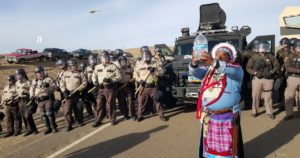 Over the past three decades, incidents like these, and the resistance they’ve spawned, have led to a much tighter regulatory environment for pipeline builders. Roger Williams, a pipeline developer from Wichita, said that in the mid-1980s he oversaw a project that laid 1,300 miles of pipe from Texas to California, crossing several states and a mountain range for good measure. At 85, he’s now vice president for operations on the 178-mile Pilgrim Pipeline project, which would serve cities in New Jersey and New York. His team has spent millions just to get to the beginning of the permitting process, including money to hire herpetologists and other wildlife experts to examine the ecological impact of the new line. After more than three years of groundwork, Williams said, “we don’t have one single permit yet.” In the meantime, the company has had to shut down a branch office in New York and lay off its staff. “They protect everything up there except human beings,” he said.
Over the past three decades, incidents like these, and the resistance they’ve spawned, have led to a much tighter regulatory environment for pipeline builders. Roger Williams, a pipeline developer from Wichita, said that in the mid-1980s he oversaw a project that laid 1,300 miles of pipe from Texas to California, crossing several states and a mountain range for good measure. At 85, he’s now vice president for operations on the 178-mile Pilgrim Pipeline project, which would serve cities in New Jersey and New York. His team has spent millions just to get to the beginning of the permitting process, including money to hire herpetologists and other wildlife experts to examine the ecological impact of the new line. After more than three years of groundwork, Williams said, “we don’t have one single permit yet.” In the meantime, the company has had to shut down a branch office in New York and lay off its staff. “They protect everything up there except human beings,” he said.
New pipelines are being thwarted in the South, too. In May, Georgia’s Republican governor, Nathan Deal, signed a moratorium on pipeline permits following intense public opposition to a proposal by Kinder Morgan for a 360-mile pipeline called the Palmetto. The line would have branched off from the company’s Plantation Pipe Line, tracing a route through Georgia, South Carolina, and Florida, and serving cities with limited or no pipeline service, such as Savannah and Jacksonville. Opposition arose almost immediately, led in part by Tonya Bonitatibus, the Riverkeeper for the Savannah River. The Palmetto was to be buried beneath miles of marshy terrain that runs alongside sensitive rivers—wetlands that serve, Bonitatibus said, as the rivers’ “liver and lungs,” by letting pollutants settle out into sediment in the shallow, slow-moving water.
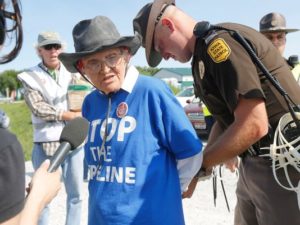 While some of the anti-Palmetto movement’s concerns were environmental, their activism took on a conservative bent. Most of the resistance focused on Kinder Morgan’s authority to use eminent domain to take property from landowners who wouldn’t cut a deal with the company, a power granted to pipeline companies by a New Deal-era law intended to spur infrastructure development. “They were incredibly arrogant the entire time,” Bonitatibus said. “There was absolutely no way that Kinder Morgan should have access to eminent domain.”
While some of the anti-Palmetto movement’s concerns were environmental, their activism took on a conservative bent. Most of the resistance focused on Kinder Morgan’s authority to use eminent domain to take property from landowners who wouldn’t cut a deal with the company, a power granted to pipeline companies by a New Deal-era law intended to spur infrastructure development. “They were incredibly arrogant the entire time,” Bonitatibus said. “There was absolutely no way that Kinder Morgan should have access to eminent domain.”
Allen Fore, a spokesman for Kinder Morgan, said that on a typical pipeline project the company uses eminent domain sparingly, invoking it for fewer than 5 percent of landowners. He added that the company had also been prepared to push ahead with Palmetto without eminent domain. But the activists’ message carried the day, and Deal passed his moratorium with the backing of conservative state legislators. Even with financing and a customer base locked in, the regulatory uncertainty was too great for Kinder Morgan to carry on. “That, at the end of the day, was the problem of Palmetto—where you have a regulatory environment that shifts,” Fore said. “The playing field is not only altered, it’s basically shut down.”
In the days after the Alabama explosion, as Butler collected water samples, employees from Colonial and L.E. Bell raced to get gasoline flowing again. The lessons of the September shutdown were fresh in their minds. They knew that oil traders and wholesalers would be counting the minutes until the pipeline reopened.
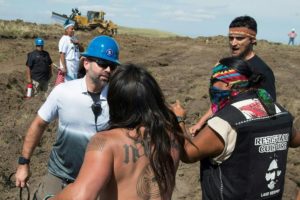 The gravel road to the accident site was guarded by a rotating shift of Shelby County sheriff’s deputies, who checked credentials and kept strangers and reporters away. Traffic was almost nonstop. Heavy trucks with the L.E. Bell logo came and went, along with vehicles from specialists and construction companies from around the Southeast. The men and women driving looked stoic, ignoring reporters as they passed by the entrance. At the site, workers prepared new sections of pipeline while fire crews sprayed smoldering tree stumps to prevent reignition. In the predawn hours of Nov. 4, four days after the blaze erupted, it finally burned out completely. The next day, the new section of pipeline was tested and prepared for use.
The gravel road to the accident site was guarded by a rotating shift of Shelby County sheriff’s deputies, who checked credentials and kept strangers and reporters away. Traffic was almost nonstop. Heavy trucks with the L.E. Bell logo came and went, along with vehicles from specialists and construction companies from around the Southeast. The men and women driving looked stoic, ignoring reporters as they passed by the entrance. At the site, workers prepared new sections of pipeline while fire crews sprayed smoldering tree stumps to prevent reignition. In the predawn hours of Nov. 4, four days after the blaze erupted, it finally burned out completely. The next day, the new section of pipeline was tested and prepared for use.
Employees of L.E. Bell appeared shellshocked in the days after the explosion. Word of Willingham’s death had spread quickly, and four of his co-workers were being treated at a burn unit in downtown Birmingham. Trays of food and gallons of coffee were sent to provision family members as they held vigil. Those who knew Willingham seemed mystified by the accident, none more so than Jeremy Slaton, his next-door neighbor and close friend. The two often shot rifles together on a grassy hillside near their homes. Slaton recalled that Willingham could hit a target from several hundred yards away. Willingham was a steady hand and a competent worker, he said, which made him doubt that a simple mistaken swipe of the track hoe blade had been entirely to blame. “It would take tremendous, tremendous force to put a back hoe, or a track hoe, tooth through a piece of pipe,” he said. “I’m thinking there’s something else … something was hidden that caused this.”
Shortly after the accident, Colonial released a statement saying that a track hoe had struck the pipeline, but the company didn’t confirm that Willingham had been driving or otherwise elaborate. The company and the National Transportation Safety Board are both investigating the accident, but neither would comment on their investigations or on the circumstances of the explosion.
Larry Bell, the owner and operator of L.E. Bell Construction, declined to discuss the explosion in detail because of the legal troubles surrounding it. He would say only that it was a “freak accident.” He said, “It had nothing to do with unsafe pipeline or workmanship. I’m not a betting man, but you’d win money on that.”
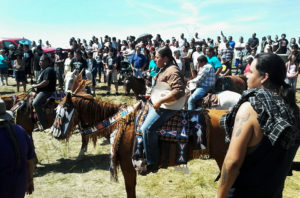 Bell lives on a large complex that also serves as his company’s headquarters, on a winding country road near Heflin, an hour or so east of Birmingham. On the left as visitors enter is a giant warehouse and open lot. Next to that is a small office building, where visitors are greeted by a caged parrot. A sign taped to the front door shows a pile of cash below the caption, “This is the money you could’ve saved if you hadn’t voted for Obama.” To the right of the office is a palatial house. The mix of home and business, Bell said, was “a country boy’s way of doing stuff.” He was quick to point out that he and his wife were born poor and had been raised in a nearby small town. “We didn’t have no rich aunts or rich uncles or daddies … but we had some good ones,” he said.
Bell lives on a large complex that also serves as his company’s headquarters, on a winding country road near Heflin, an hour or so east of Birmingham. On the left as visitors enter is a giant warehouse and open lot. Next to that is a small office building, where visitors are greeted by a caged parrot. A sign taped to the front door shows a pile of cash below the caption, “This is the money you could’ve saved if you hadn’t voted for Obama.” To the right of the office is a palatial house. The mix of home and business, Bell said, was “a country boy’s way of doing stuff.” He was quick to point out that he and his wife were born poor and had been raised in a nearby small town. “We didn’t have no rich aunts or rich uncles or daddies … but we had some good ones,” he said.
Bell dropped out of high school to work as a laborer on the Colonial in the early 1960s. He remembered when the pipeline ran its first gallons to fuel. His company now employs about 500 people, who help maintain the aging Colonial and other pipelines like it across the country. Colonial Pipeline, he said, goes “extremely overboard to make sure everything is done right and everything is safe.” He described pipelines as a necessity of modern life. “If we lined up trucks to transport our product from Louisiana and Texas to the East Coast, we wouldn’t have any room on the interstate to run our cars,” he said. “Anything we do has got risk to it. There’s nothing that man makes that does not have a risk to it.”
Dunn, Colonial’s spokeswoman, wouldn’t say what specific actions the company will take to boost reliability. “When incidents do occur, we investigate and determine the cause alongside government regulators, and take corrective actions based on lessons learned to minimize the likelihood of similar events happening again in the future. We are doing the same here,” she wrote in an e-mail. After each previous major accident, the company agreed to improve safety practices as part of its settlement with federal regulators.
This year’s incidents appear to be affecting the company’s bottom line. In 2015, according to Moody’s, Colonial spent $163 million on capital investments, which includes measures for system reliability. This year the figure is almost double that, roughly $300 million. That’s about the same amount the company has been returning to its shareholders in dividends in recent years, but Moody’s notes that Colonial will reduce the payouts this year because of the accidents. Koch Industries declined to comment.
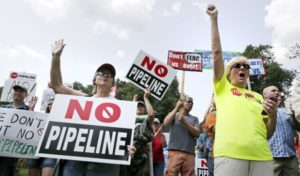
It’s possible that the presidency of Donald Trump will change the regulatory environment for pipelines, clearing the way for the Dakota Access to be completed and for the construction of the Keystone XL and other lines. But it’s unclear how much impact even a determined White House could have, given that most pipeline battles are fought at the lower levels of government. Moreover, gasoline supply crunches won’t likely persuade the environmental groups that pressured President Obama to kill Keystone XL and are now protesting the Dakota Access to back down from their objections. “My worries about ‘infrastructure fragility’ tend more towards, say, the effects of rapid sea level rise on the nation’s coastal cities,” wrote author and activist Bill McKibben, co-founder of the nonprofit 350.org, in an e-mail.
Environmentalists’ fight, he pointed out, is about more than preventing leaks—it’s a way to curb the construction of infrastructure that supports the oil and gas industry. “The imperative need is to wean the world fast off fossil fuels—this is the hottest year our planet has ever recorded, with record-low polar ice for the date, with massive droughts and floods,” McKibben wrote. “When we build new fossil fuel infrastructure we condemn the nation to another 40 or 50 years locked into the current way of doing business.”
For now, at least, the risks of climate change, water contamination, and species loss remain the trade-off for driving our cars and heating our homes. By Sunday, Nov. 6, the Colonial was up and running again. Gas prices had barely been disrupted, leaving some 50 million people to forget once again what an important role a single tube of steel and the company that owns it play in their daily lives.
Butler’s water tests from the accident site came back negative for gasoline. It was great news for him and the oblong rocksnail, but he wasn’t celebrating. Instead, he was nervous that the next call from Colonial would be coming soon enough. The risk was always hanging out there, he said. “It’s sort of a guillotine.”
___


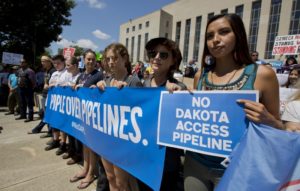

1 Comment
Hi Jim,
The OTHER Jim Riordan here. Your article on the Pipeline was GREAT!
Hope all is well with you and yours. I am just getting ready to launch a new website to feature some of my writings and I will send you a link when it is made live. Five thumbs up for ya brother!